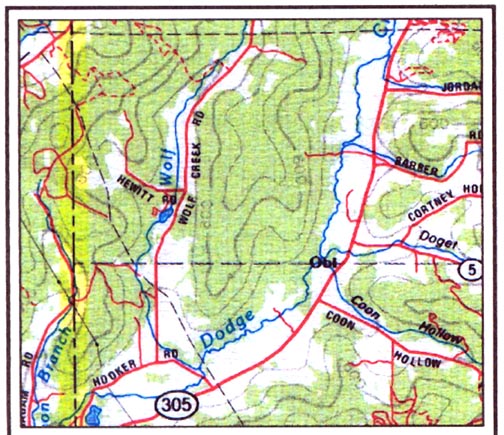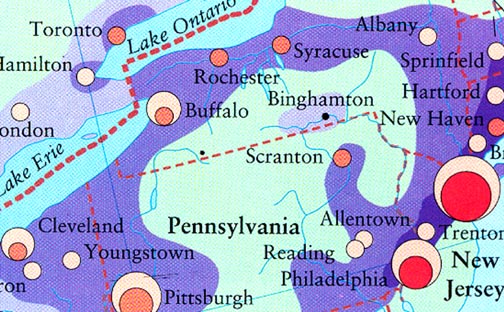|
In order to get a better grip on the Cabin Story, one needs to take a quick look at
the geography and history of the Irish Basin. Glancing at the bigger picture reveals important facts about the land
and people of Portville and the surrounding area.
There are some interesting stories and dramas that precede and surround the formation
of the Obi Cabin gang of the late 70s.

The Irish Basin is located just west of Obi, New York in Allegany County. The Basin entrance
opens up on the north side of Dodge Creek, right behind the West Genesee Cemetery (above picture).
The front portion of the Irish Basin lies in the town of Genesee, but most of the valley is in the
Clarksville township. At this location, Dodge Creek is at 1,400 feet above sea level. The top of the Basin rises
to 2,222 feet.
The whole hill into which the Basin loops is bordered on the east and south by Route 305
and on the west by Wolf Creek. The hill forms a finger-like projection deep into the town's wilderness, and
it is one of many, similar projections of a larger hill formation that dominates the area.

During the last Ice Age (20,000 years ago), the Laurentide Glacier covered almost all of what is
now New York State. This monstrocity was 1,000 feet high and crushed everything in its patient, powerful path.
When it began to melt and recede (~15,000 years ago), its southern-most edge in New York formed an outline of the Allegheny
River.
The Irish Basin was created out of the glacier's folding of the landscape. Regionally, the
Basin is located on the Allegheny Plateau, which is part of the Allegheny Mountains, which is part of the great Appalachian
Mountains.
The first humans to visit the Irish Basin may have arrived 5 to 10,000 years ago. These PaleoIndians
began to build large, earthen mounds for burial, religious, and artistic purposes. By the time of Christ, the Hopewell
Culture from Ohio had spread throughout New York.
When the first Euro-Americans journeyed through the area, they came across many of these mounds.
Native Americans treated this region around the Allegheny River as sacred hunting grounds.
No permanent settlements were established in the area for at least 500 years. It was a dangerous territory filled
with wild game and predators...wolves, bear, panthers, coyotes, and bobcats. At times, the various tribes vied for superiority
of the hunting land.
The Erie, Iroquois, and other tribes came here for annual fishing and hunting expeditions.
But after the American Revolution, permanent human settlement by the Indians and Euro-Americans finally occurred.
George Irish Sr. was one of the first men to settle in the area between Portville and West Clarksville...arriving
around 1830. He built a house at the bottom of the basin that bears his name. The foundation to the structure
can still be seen, located just 100 yards from the Obi Log Cabin built in 1975. George's sons ended up fighting
in the Civil War for the 85th Regiment of the Union.
Both were captured by Confederate forces in South Carolina on April 20, 1864 and sent to the infamous
Andersonville Prison in Georgia. George died from starvation and dehydration before his luckier brother Edgar could
help him. Edgar was utilized in the office of the prison, and he secretly kept and stole documents that eventually
led to the conviction of the prison commander after the war. His tombstone is in the West Genesee Cemetery...at
the entrance to the Basin.
After the Civil War, the Little Red Schoolhouse was built next to the cemetery... attracting kids
from the Coon Hollow-Obi area. Edgar Irish became the teacher, sharing lessons from the war with the children.
Some folks have contemplated doing an archeological dig in the wooded area in front of Wimp's house.



The first people to inhabit the Obi area were farmers, who came in after the lumber men had cleared
portions of the wilderness. Many bought land from the Holland Land Company during the 1800s. Mills and farms were
the way of life for these simple pioneers.
Between 1850 and 1950, as the Industrial Revolution and Age of Invention propelled the Great Lakes
and Northeast regions into an industrial belt with no equal in the world...the little wilderness of Obi found itself
in the middle of it all, yet isolated in the Appalachian hills of New York.
During the late 1800's, the hamlet of West Genesee also had a 7th Day Baptist Church (across the
road from Keith Wood's present home), attended by local residents from a few clans - Maxson, Childs, Crandall, and Coon.
In 1900, Buffalo was the 6th largest city in the country. Also on the rise were Cleveland,
Pittsburgh, and Rochester. The rapid pace of the cities was in sharp contrast to the slower, rural speed of Portville
people. Farms dominated the Dodge Creek banks and oil wells were erected on top of the hills around Coon Hollow and
Daggatt Hollow.
|

